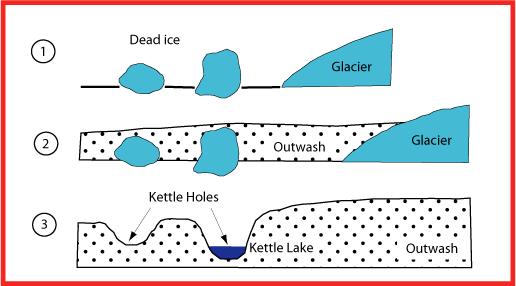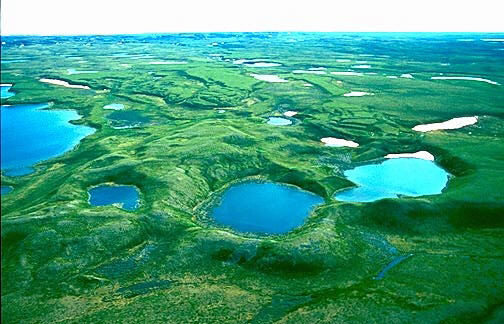Eskers
These are ridges of well sorted sand and gravel several kilometres long and up to thirty metres in height, that are created by water that runs within tunnels in and underneath a glacier. The amount of rock debris in the ice, as well as the speed in which the sediment is delivered to the tunnel from upstream determines the amount of sediment in the esker, with it usually consisting of between pebble and cobble size material. When a glacier retreats the debris is deposited from the channel of water and onto the land where it forms a linear mound that is parallel to the path of the original glacial river. Eskers tend to form at the terminal zone of glaciers where the ice moves more slowly and can be singular, or can contain tributary eskers. The path of eskers tends to be governed by water pressure in relation to overlying ice, with the general pressure of the ice allowing eskers to run in the direction of glacial flow (even uphill) whilst forcing them into valleys or river beds to keep them in the lowest possible points (even if this means allowing them to deviate from the glacial path). This therefore produces the wider eskers which roads and so on can be built upon.
An example of some eskers are:
- Uppsalaåsen in Sweden which runs for 156 miles
- Kemb Hills in Scotland which is 5km long
- Mason Esker in the USA which is 22 miles long
- Thelon Esker in Canada which is approximately 500 miles long
Kettle Lakes
These form when glaciers recede. As this happens it is possible for blocks of ice to break off the glacier and remain in place. With the continual recession of the glacier there comes an increase in meltwater that carries debris which flows down to the block of ice, therefore beginning to form around its edge. When the partially buried ice-blocks melts, the surrounding debris falls into the hole (without filling it completely) therefore leaving a depression within the land known as a kettle hole, with most kettle holes being no more than two kilometres wide and ten metres deep. As these depressions begin to fill with water from streams and rivers they are known as kettle lakes. If however they fill with water from precipitation or the ground water table they are classed as a kettle pond or kettle wetland. If a kettle pond is not affected by the ground water table but fills only with water from precipitation then it will usually become dry during summer months and as such will be classed as ephemeral. If however the water within a kettle becomes acidic due to decomposing organic matter then it will instead be classed as a kettle bog or kettle peatland. When numerous kettle holes occur, ridges and mounds begin to form between them which resemble glacial kame.
Kettle lakes can be found all over the world such as in:
- Canada (Kettle Point)
- England (Hatchmere)
- Scotland (Loch Fergus)
- Germany
How kettle lakes are formed
Kettle lakes
Truncated Spurs
This is caused when a river initially erodes vertically to create a ‘V’ shaped valley. During erosion the river meanders around the hardest rock and erodes through the softest, therefore creating interlocking spurs. When a glacier then flows down a former river valley it is unable to travel around the spurs as the river was able to do and as such it follows a straighter course by eroding straight through their tips, therefore forming truncated spurs. Hanging valleys are often found between truncated spurs as they join the main glacial valley from the side.
The top image shows interlocking spurs. The lower image shows how they have changed into truncated spurs.
Kames
Kames are mounds of sediment (specifically sorted into just sand and gravel) that are deposited along the snout of a receding or stationary glacier. The sediment continues to build up as the ice melts with further sediment being deposited on top of existing sediment therefore creating mounds. Kame terraces however are formed when troughs are created at the side of a glacier due to the warm valley rock in the summer melting the ice, with meltwater streams carrying, sorting and depositing the sediment. Kame deltas occur however when streams carry sediment to glacial lakes and during this process build the kame deltas upon the ice. When the glacier melts, the kame delta will collapse upon the top of the land, therefore often forming the ‘kame and kettle’ topography. The difference between a moraine and a kame is that the sediment in a kame is carried by water and is therefore sorted into sand and gravel whereas moraines consist of all types of debris due to being carried by ice.
Glacial kame
Kame terrace






No comments:
Post a Comment